Are you a Quiet Speculation member?
If not, now is a perfect time to join up! Our powerful tools, breaking-news analysis, and exclusive Discord channel will make sure you stay up to date and ahead of the curve.
Looking solely at the Top 16s of recent events, observers might argue that Modern has become shockingly interactive. Todd Stevens' Sun and Moon, a white-red prison deck with a midrange slant, just won a Star City Games Open in Knoxville, headlining a Top 16 packed with more Sun and Moon, Skred Red, and Jund. Earlier this month, Skred Red beat out Grixis Control in the finals of GP Dallas. That tournament's Top 8 even housed a Jeskai Control deck. Given these results, is Modern is as linear and aggressive as people like to claim?

Well, yes. When we look at the decks that did well over the course of the latest GP, the format's true colors reveal themselves. In terms of representation, Infect dominated GP Knoxville, closely followed by Bant Eldrazi, Dredge, Burn, Death's Shadow Zoo, and RG Titan decks. Sun and Moon, Grixis Control, and Skred Red were able to rise to the top of these metagames because they interact efficiently from the standpoint of both mana and card economy—two keys to dismantling linear aggro strategies.
[wp_ad_camp_1]
How to Interact
There are two ways to interact efficiently in Modern. One involves playing the cheapest, most effective spells the format has to offer, including Lightning Bolt, Path to Exile, and Inquisition of Kozilek. The other employs highly relevant lock pieces to stop a large number of an opponent's cards with a single play.
Lock Pieces
We'll start with the elephant in the room. Modern has at last become a format that welcomes Chalice of the Void. With BGx decks relaxing their historic stranglehold on the format as more linear aggro decks are inducted into Modern, Chalice is making its rounds as a mainboard and sideboard hoser found in decks as diverse as Bant Eldrazi, RG Titan decks, and certain control builds.
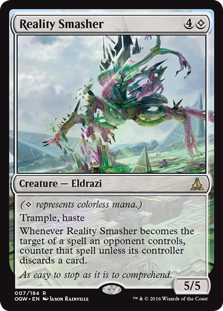 The meteoric rise of Bant Eldrazi to Modern's forefront has also created prime conditions for Blood Moon, a card that already hassles interactive three-color decks and can be splashed into a variety of archetypes itself (among them Affinity, Grixis, Temur, Zoo). Moon also leads the disruption suite in a few decks, including the rarely seen Blue Moon, the more present RG Ponza, and Stevens' Sun and Moon, a deck now exploding in popularity.
The meteoric rise of Bant Eldrazi to Modern's forefront has also created prime conditions for Blood Moon, a card that already hassles interactive three-color decks and can be splashed into a variety of archetypes itself (among them Affinity, Grixis, Temur, Zoo). Moon also leads the disruption suite in a few decks, including the rarely seen Blue Moon, the more present RG Ponza, and Stevens' Sun and Moon, a deck now exploding in popularity.
The main draw to Sun and Moon is its ability to run both Blood Moon and Chalice of the Void. Sun and Moon threatens to power either piece out a turn early with Simian Spirit Guide, potentially locking opponents out of the game on turn one.
Lightning Helix and Journey to Nowhere, clunkier versions of Bolt and Path, evade Chalice themselves and give the deck cheap creature removal for those that slip past its lock pieces. Sun and Moon also plays multiple sweeper effects, including Anger of the Gods, and can even interact with its win conditions, Nahiri, the Harbinger and Chandra, Torch of Defiance.
The deck's ability to play as a functioning midrange strategy when it isn't free-winning off of lock pieces makes it more robust than traditional prison decks like Lantern Control. With Dredge a known quantity now, I expect we'll see tons of Sun and Moon in the near future as more players pick up the relatively cheap deck to take back those wins from Infect.
Cheap Answers and Threats
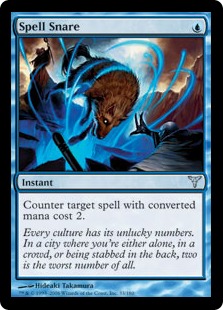 The preferred method of interacting efficiently in Modern is to run a suite of the format's consensus best cards. Corey Burkhart's Grixis Control deck from GP Dallas exemplifies this principle. While Corey ran more expensive answers like Cryptic Command, Kolaghan's Command, and even Terminate, he compensated for these with a wealth of early-game plays, including Lightning Bolt and Spell Snare. Corey also ran Engineered Explosives in the main to have access to a cheap sweeper against decks full of one-drops.
The preferred method of interacting efficiently in Modern is to run a suite of the format's consensus best cards. Corey Burkhart's Grixis Control deck from GP Dallas exemplifies this principle. While Corey ran more expensive answers like Cryptic Command, Kolaghan's Command, and even Terminate, he compensated for these with a wealth of early-game plays, including Lightning Bolt and Spell Snare. Corey also ran Engineered Explosives in the main to have access to a cheap sweeper against decks full of one-drops.
His most interesting decision, though, was to max out on Thought Scour despite only running three copies of Tasigur, the Golden Fang as delve spells. Grixis Control decks have been known to dip into Gurmag Angler, but Corey forewent the Zombie Fish in favor of a leaner threat suite. Without Gitaxian Probe, Corey was sure to need a little extra help when it came to rushing out Tasigur on turn two, a crucial play against board-blitz decks like Burn and Zoo. The four copies of Scour all but ensured his success on that front, allowing him to impact the board sooner and for less mana.
Kevin Mackie's Skred Red happens to straddle both sides of the coin, running Lightning Bolt and Skred (a Path to Exile upgrade in a deck full of Snow-Covered Mountains) in addition to lock pieces Relic of Progenitus and Blood Moon. This combination makes the unassuming deck a serious contender in a metagame so soft to spot removal and lock pieces.
The Importance of Pressure
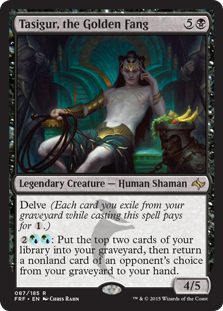 Opponents do draw out of lock pieces eventually. They draw out of removal spells even quicker. It's crucial to put pressure on opponents if cheap interaction is to actually beat them.
Opponents do draw out of lock pieces eventually. They draw out of removal spells even quicker. It's crucial to put pressure on opponents if cheap interaction is to actually beat them.
Burkhart's super-reliable Tasigurs fits the bill here, complimented by Snapcaster Mage who makes ending games with reach par for the course. Kolaghan's Command can recycle both creatures in the Grixis Control list, explaining why Corey didn't run more threats at GP Dallas than he did.
Both Skred Red and Sun and Moon rely on planeswalkers to take the game, the former powering out turn-three Koths with Mind Stone and the latter slamming Nahiri on curve after crippling an opponent's options with a lock piece. Simian Spirit Guide can also help get the deck's planeswalkers ticking up a turn early. Skred Red even has a recurring Wild Nacatl in the form of Eternal Scourge.
Pawing It All Together
The way Modern's been heading over the last couple months has made me miss Path to Exile. I sleeved the card back up and have been putting in rounds with an updated build of Counter-Cat, which I think is very well-positioned in this metagame. Here's the list:
Counter-Cat, by Jordan Boisvert
Counter-Cat packs a ton of efficient interaction and front-loads a lot of pressure, making it a strong contestant in such a linear metagame. Creature-based matchups like Zoo, Infect, Death & Taxes, and Merfolk are practically byes for this deck.
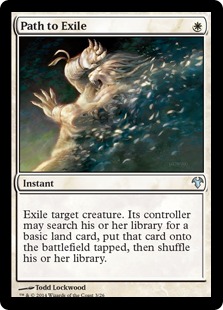 I've been considering taking Counter-Cat to the RPTQ next month over Temur Delver for these reasons. The deck is also more resilient to removal than Monkey Grow, since it plays more threats. With hard kill spells like Terminate and Path to Exile showing up in large numbers again, as well as graveyard hate for Dredge like Rest in Peace, I'd rather have a grip of Nacatls than a single Tarmogoyf.
I've been considering taking Counter-Cat to the RPTQ next month over Temur Delver for these reasons. The deck is also more resilient to removal than Monkey Grow, since it plays more threats. With hard kill spells like Terminate and Path to Exile showing up in large numbers again, as well as graveyard hate for Dredge like Rest in Peace, I'd rather have a grip of Nacatls than a single Tarmogoyf.
The points we lose against linear decks by giving up Disrupting Shoal are mitigated by adding Path to Exile and Lightning Helix, since most linear decks in Modern are currently creature-based. Countering Insolent Neonate or Expedition Map on turn zero is less important when we can reliably "go Zoo" and race the degenerate decks the old fashioned way instead of spending a turn or two digging into pressure.
Unfortunately, Counter-Cat is very weak to Sun and Moon. Chalice and Blood Moon both give the deck a hard time, and planeswalkers only add insult to injury. It's draw Spell Pierce or bust in this kind of matchup, and the degree to which players adopt the new strategy will influence my final choice for December.
Digging Deeper
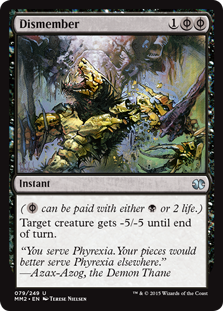 Modern has a vast card pool and in most cases can, I believe, police itself. I like to think that if Wizards had left Twin or Bloom in the format, Delver decks would eventually have surfaced in larger numbers to combat them. It's still just a matter of time, but it will take longer than it might have.
Modern has a vast card pool and in most cases can, I believe, police itself. I like to think that if Wizards had left Twin or Bloom in the format, Delver decks would eventually have surfaced in larger numbers to combat them. It's still just a matter of time, but it will take longer than it might have.
In the meantime, I think one card in particular deserves a lot more play than it has seen: Dismember. It's a freeroll removal spell against Infect, and stellar against any creature deck outside of Burn. On top of all that, any deck can play it—even colorless ones, or decks with Chalice of the Void!


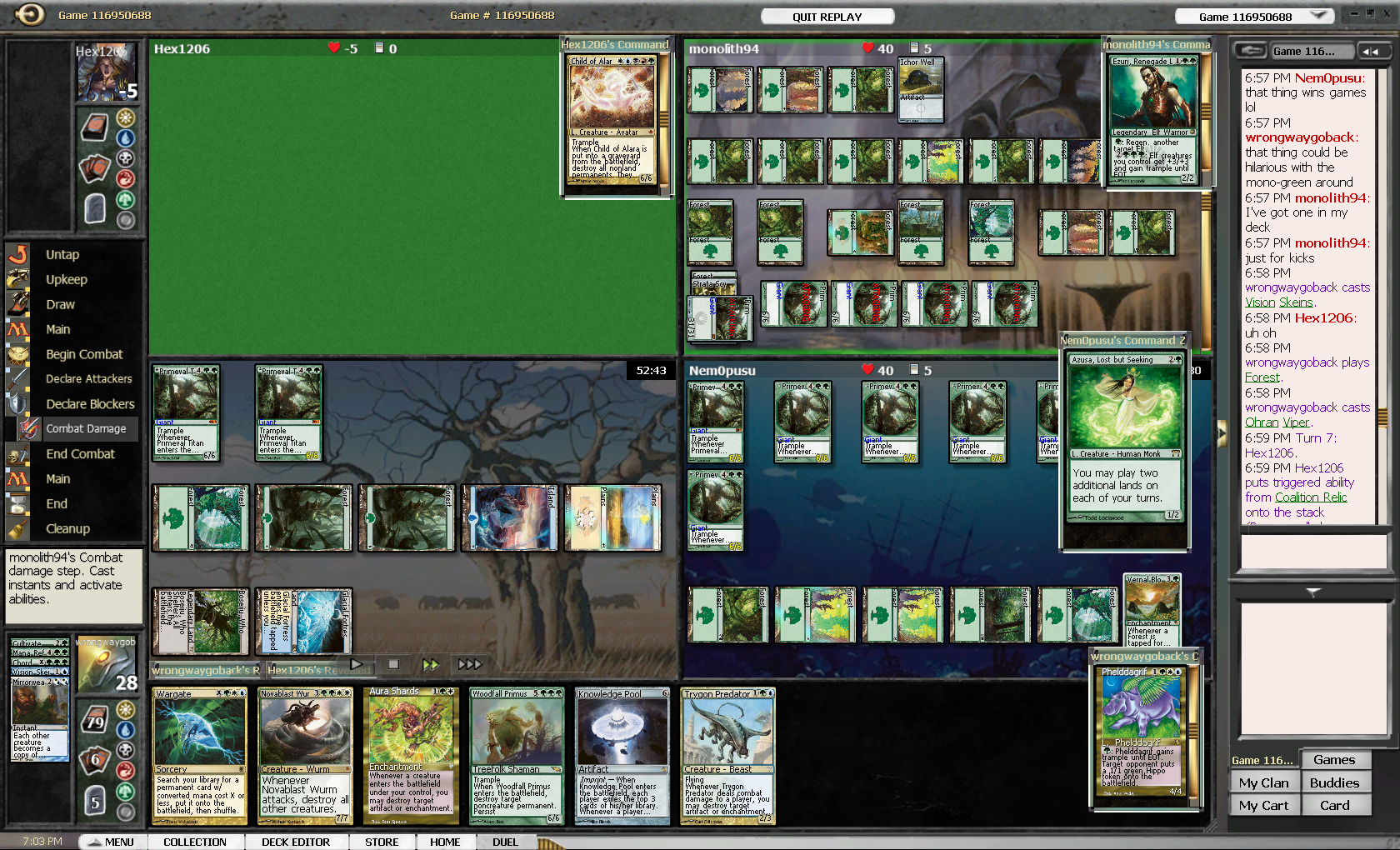


I’m with you on a large part of this article, but I’m not a fan of Dismember. It’s actively detrimental against Burn, and it’s not exactly stellar against Dredge (who doesn’t care if its creatures die, and puts huge early pressure on your life total), Death’s Shadow Zoo (who has threats that outgrow it), and Suicide Bloo/UR Prowess (ditto). My point is backed up by the fact thtat Merfolk players have mostly dropped it, and have seen better results since bringing Vapor Snag back into the fold in its place. It being a freeroll against Infect isn’t good enough, in my opinion.
I agree about Dredge and Burn, but I love it against the other two decks. Color combinations that have no way to get an 0/4 off the table will love it against UR Prowess, since it kills Thing right away, not to mention Kiln Fiend or Swiftspear in a pinch. It also kills the weaker threats in DSZ past a Mutagenic Growth, as well as a 1/1 Death’s Shadow + Mutagenic Growth, and takes care of their Mandrills post-board and most of their Goyfs.
Decks without blue can’t run Vapor Snag, and Snag is only better than Dismember some percentage of the time. When you’re employing a midrange plan and trying to win on card advantage, as many aggro-control decks often do, you can’t afford to just be bouncing threats. I know Merfolk is frequently on the aggro side of things, so it’s not too relevant for that deck, but I’m really liking a copy in the Monkey Grow sideboard right now.
It’s also been awesome in GR Moon as a 4-of. Helps get us past the early game so we can start playing Moons, Goyfs, and Huntmasters. Can even cycle away extras to Faithless Looting. I’d be surprised if we didn’t see it start to get more play in archetypes that struggle to make it to turn three-four but handily take over the game from there.
Speaking of G/R Moon, I love the deck and have been playing the heck out of it for probably about the last 6 months or so, but I’ve been struggling to find a good solution to goyfs in that particular color combination, especially once they grow to the magic 6 toughness to live through dismembers. Any thoughts?
Dismember helps a lot by killing early Goyfs. Later ones can still be problematic but by that point in the game we should have a Moon down and be pressuring pretty hard with Huntmasters and Goyfs of our own. It’s really the early Goyfs from opponents that we have to worry about, since those are the ones that get aggressive.
Since later Goyfs from opponents are frequently on the defensive, we’re happy to sit back and flip Huntmaster for awhile or to just swing with an exalted Goyf to blow through defenses.
“Double-Bolting” Goyfs also works for us, even if one Bolt is a Tarfire and one is a Dismember, or one is a Chandra hit and one is a Bolt, or whatever. We have a ton of removal spells and it’s really only Goyf that’s going to give us trouble out of the decks that run him so it’s usually fine for us to spend two cards getting rid of one.
What is your take on the Tom Ross special of GW Tron? I am surprised that path to exile main was enough removal now that infect runs 7-8 hexproof instants. Perhaps he concedes g1, and relies heavily on Blessed Alliance from the board?
I look forward to meeting you at the RPTQ in Montreal. I appreciate the content and analysis and I have no illusions that I’ll have the opportunity to meet you again as I’m new to Magic and lucked my way through my first PPTQ. Anyways, keep an eye open for me. I’lol be the only one over 40 there I imagine!
Blessed Alliance plugs a ton of holes in a lot of strategies. I think GW Tron looks great right now, much better than GR in fact. Pyroclasm/Firespout are a lot less effective against the pump decks showing up than Path is. There’s always Fog to combat Infect, too.
Unfortunately, I’ll be playing at an RPTQ near Boston since I just moved. But I’ll probably be in Montreal for the bigger events coming up next year!
Oh wow, that’s this weekend then! Good luck to you; see you around GP Montreal in May perhaps!
17 Creatures seems like a lot for a Delver deck, is it flipping reliably?
Since you cut out the Shoals (so no need for a fixed blue count), why not Monastery Swiftspear?
If you look at the list you’ll see that it plays 25 instants and sorceries. That’s the important part, not how many creatures the deck plays. Nacatl is the main reason to splash white into RUG Delver shells for the reason that, over Swiftspear, it allows us to play more reactively with a threat on the table. Swiftspear would regularly attack for 1 in this deck, which is unacceptable.
Counter-Cat is a vastly different deck from Monkey Grow, even though they play many of the same cards. You can read more about it here:
https://quietspeculation.com/delver-teeth-introducing-counter-cat/
https://quietspeculation.com/delver-bulk-counter-cat-practice/